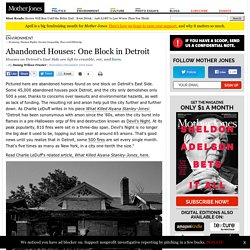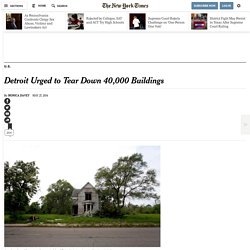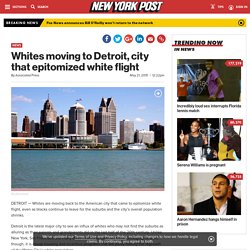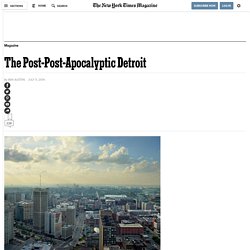

Miguel
Abandoned Houses: One Block in Detroit. Pictured here are abandoned homes found on one block on Detroit's East Side.

Some 45,000 abandoned houses pock Detroit, and the city only demolishes only 500 a year, thanks to concerns over lawsuits and environmental hazards, as well as lack of funding. The resulting rot and arson help pull the city further and further down. As Charlie LeDuff writes in his piece What Killed Aiyana Stanley-Jones: "Detroit has been synonymous with arson since the '80s, when the city burst into flames in a pre-Halloween orgy of fire and destruction known as Devil's Night.
At its peak popularity, 810 fires were set in a three-day span. Devil's Night is no longer the big deal it used to be, topping out last year at around 65 arsons. Read Charlie LeDuff's related article, What Killed Aiyana Stanley-Jones, here. Detroit Urged to Tear Down 40,000 Buildings. “Detroit needs to act aggressively to eradicate the blight in as fast a time as possible,” the report concluded, noting that the city needed to move faster than any other city contending with a high level of decay to keep matters from growing even worse.

City leaders call for ending blight in the city’s residential neighborhoods in five years, while acknowledging that dealing with big empty industrial buildings — some 559 of them — could take longer. “These structures are unique because of their larger size and their potential for greater environmental issues than other structures,” the report said, noting that the cost of demolishing just a single large industrial building can run into the tens of millions of dollars. OPEN Map. The Old Neighborhood. To Do List. Detroit pays high price for arson onslaught. Detroit — Arson is a raging epidemic in Detroit, destroying neighborhoods and lives as the city tries to emerge from bankruptcy.

Even amid a historic demolition blitz, buildings burn faster than Detroit can raze them. Last year, the city had 3,839 suspicious fires and demolished 3,500 buildings, according to city records analyzed by The Detroit News. Burned homes scar neighborhoods for years: Two-thirds of those that caught fire from 2010-13 are still standing, records show. "Nothing burns like Detroit," said Lt. Joe Crandall, a Detroit Fire Department arson investigator, referring to the city's high rate of arson. The Detroit News researched arson for more than three months and found that it remains a huge obstacle to renewal efforts following bankruptcy.
Few neighborhoods were untouched by arson and the entire city bears its costs. "People don't realize arson is a felony. Arson Chief Charles Simms said the city is making progress in its long struggle with arson. Who Wants to Live in Detroit? This article is from the archive of our partner DETROIT—In most cities, the opening of a new Starbucks or chain grocery store is no big deal.

But this is Detroit. "No [chain businesses] wanted to move here. It's all about perception. They thought it was too dangerous," says Jordan Twardy, executive director of the Eight Mile Boulevard Association. Part of Twardy's job involves attracting businesses to the Eight Mile corridor, the notorious dividing line between black and white Detroit made famous in the rap lyrics of Eminem. As Twardy drives along along Eight Mile in his Chevy Cruze, he points to the Gateway Marketplace on the south side of the street, where a Starbucks opened last year and where the city's second national chain grocery store, Meijer, opened a year earlier.
"We're not hanging banners just yet," says Twardy, who is white and lives in a suburb north of Eight Mile. "We're on our way back. " It definitely seems that way at first glance. Whites moving to Detroit, city that epitomized white flight. DETROIT — Whites are moving back to the American city that came to epitomize white flight, even as blacks continue to leave for the suburbs and the city’s overall population shrinks.

Detroit is the latest major city to see an influx of whites who may not find the suburbs as alluring as their parents and grandparents did in the last half of the 20th century. Unlike New York, San Francisco and many other cities that have seen the demographic shift, though, it is cheap housing and incentive programs that are partly fueling the regrowth of the Motor City’s white population.
“For any individual who wants to build a company or contribute to the city, Detroit is the perfect place to be,” said Bruce Katz, co-director of the Global Cities Initiative at the Washington-based Brookings Institution. “You can come to Detroit and you can really make a difference.” “A young person can move here with $10,000 and start up a small flex space for artists or artists’ studios,” Seger said.
Elizabeth St. St. Marilyn Salenger: ‘White flight’ and Detroit’s decline. By Marilyn Salenger By Marilyn Salenger July 21, 2013 Marilyn Salenger is president of Strategic Communications Services and a former correspondent and news anchor for several CBS stations.

An almost palpable sadness has swept across the country at the news that the city of Detroit has filed for bankruptcy. While the possibility of this had been discussed, the reality of what was once the fourth-largest city in the United States sinking to such depths is disheartening, a moment people will remember for years to come. To understand that the decline and bankruptcy represent so much more than dollars and cents requires a step back to a time that many would prefer to forget but remains unforgettable. Detroit Foreclosure Crisis « Center for Advancing Research and Solutions for Society.
More than just an empty house In the late 1990’s and early 2000′s lenders pushed subprime mortgages and mortgages with exotic terms in many of Detroit’s working class and middle class neighborhoods.

Then the recession hit, and the foreclosure crisis spread to include homeowners with conventional mortgages who’d lost their jobs. The combined effect has been devastating to Detroit’s neighborhoods. By late 2011 foreclosure had touched one in every four habitable houses in the city – more than 63,000 of them. Even in middle-class neighborhoods, hundreds of houses sit vacant, vulnerable to neglect and vandalism. ”Vacancy and increasing blight undermine residents’ confidence in the future of their neighborhood,” said University of Michigan urban planning professor and project co-leader Margaret Dewar.
Helping neighborhoods fight blight. Volume of abandoned homes 'absolutely terrifying' Detroit — Detroit has had more homes foreclosed in the past 10 years than the total number of houses in several suburbs — or all of Buffalo, New York.

Since 2005, more than 1-in-3 Detroit properties — 139,699 of 384,672 — have been foreclosed because of mortgage defaults or unpaid taxes, property records show. The vast majority are houses, and the tally is so huge it shocked even those who spent years working on foreclosure in Detroit. "When you see it on a map, it's absolutely terrifying," said Chris Uhl, a vice president of the Skillman Foundation that is working to prevent foreclosures. Detroit MI Home Prices & Home Values. The Post-Post-Apocalyptic Detroit. Photo In downtown Detroit, at the headquarters of the online-mortgage company Quicken Loans, there stands another downtown Detroit in miniature.

The diorama, made of laser-cut acrylic and stretching out over 19 feet in length, is a riot of color and light: Every structure belonging to Quicken’s billionaire owner, Dan Gilbert, is topped in orange and illuminated from within, and Gilbert currently owns 60 of them, a lordly nine million square feet of real estate in all. He began picking up skyscrapers just three and a half years ago, one after another, paying as little as $8 a square foot. He bought five buildings surrounding Capitol Park, the seat of government when Michigan became a state in 1837.